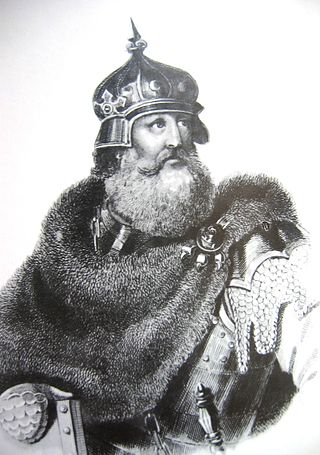
The Grand Duchy of Lithuania was a European state that existed from the 13th century to the late 18th century, when the territory was partitioned in 1795 among the Russian Empire, the Kingdom of Prussia, and the Habsburg Empire of Austria. The state was founded by Lithuanians, who were at the time a polytheistic nation born from several united Baltic tribes from Aukštaitija.

Kęstutis was the Grand Duke of Lithuania. He was the Duke of Trakai and governed the Grand Duchy of Lithuania, 1342–1382, together with his brother Algirdas, and with his nephew Jogaila.

The House of Gediminid or simply the Gediminids were a dynasty of monarchs in the Grand Duchy of Lithuania that reigned from the 14th to the 16th century. A cadet branch of this family, known as the Jagiellonian dynasty, reigned also in the Kingdom of Poland, Kingdom of Hungary and Kingdom of Bohemia. Several other branches ranked among the leading aristocratic dynasties of Russia and Poland into recent times.
Tautvilas or Towtwil was one of the sons of Kęstutis, Grand Duke of Lithuania, and a strong supporter of his brother Vytautas the Great in his struggles against their cousin Jogaila.

Skirgaila was a regent of the Grand Duchy of Lithuania for his brother Jogaila from 1386 to 1392. He was the son of Algirdas, Grand Duke of Lithuania, and his second wife Uliana of Tver.

Lithuania proper refers to a region that existed within the Grand Duchy of Lithuania where the Lithuanian language was spoken. The primary meaning is identical to the Duchy of Lithuania, a land around which the Grand Duchy of Lithuania evolved. The territory can be traced by Catholic Christian parishes established in pagan Baltic lands of the Grand Duchy of Lithuania subsequent to the Christianization of Lithuania in 1387. The Lithuania Proper was always distinguished from the Ruthenian lands since the Lithuanians differed from the Ruthenians in their language and faith. The term in Latin was widely used during the Middle Ages and can be found in numerous historical maps until World War I.

The Treaty of Dovydiškės, Daudiske, or Daudisken was a secret treaty signed on 31 May 1380 between Jogaila, the Grand Duke of Lithuania, and Winrich von Kniprode, the Grand Master of the Teutonic Knights. The treaty was directed against Jogaila's uncle Kęstutis and its effect was to precipitate the Lithuanian Civil War (1381–1384).

Edvardas Gudavičius was a Lithuanian historian. He was known as one of the best historians in Lithuania specializing in the early history of Grand Duchy of Lithuania and is an author of many publications.
The Lithuanian Council of Lords was the main permanent institution of central government in the Grand Duchy of Lithuania active in its capital city of Vilnius.

The family of Gediminas is a group of family members of Gediminas, Grand Duke of Lithuania, who interacted in the 14th century. The family included the siblings, children, and grandchildren of the Grand Duke and played the pivotal role in the history of Lithuania for the period as the Lithuanian nobility had not yet acquired its influence. Gediminas was also the forefather of the Gediminid dynasty, which ruled the Grand Duchy of Lithuania from 1310s or 1280s to 1572.

The Duchy of Lithuania was a state-territorial formation of ethnic Lithuanians that existed from the 13th century to 1413. For most of its existence, it was a constituent part and a nucleus of the Grand Duchy of Lithuania. Other alternative names of the territorial formation, used in different periods, were Aukštaitija or Land of Lithuania, Duchy of Vilnius, Lithuania proper, or simply Lithuania.

The Ostrów or Astrava Agreement was a treaty between Jogaila, King of Poland and Grand Duke of Lithuania, and his cousin Vytautas the Great, signed on 4 August 1392. The treaty ended the destructive Lithuanian Civil War, launched in 1389 by Vytautas who hoped to gain political power, and concluded the power struggle between the two cousins that erupted in 1380 after Jogaila secretly signed the Treaty of Dovydiškės with the Teutonic Knights. The Ostrów Agreement did not stop attacks from the Teutonic Knights and the territorial dispute over Samogitia continued up to 1422. According to the treaty, Vytautas became the ruler of Lithuania, but he also acknowledged Jogaila's rights to Lithuania. The details of the Polish–Lithuanian relationship were clarified in several later treaties, including the Union of Vilnius and Radom in 1401 and Union of Horodło in 1413.

The Lithuanian Civil War of 1389–1392 was the second civil conflict between Jogaila, King of Poland and Grand Duke of Lithuania, and his cousin Vytautas. At issue was control of the Grand Duchy of Lithuania, then the largest state in Europe. Jogaila had been crowned King of Poland in 1386; he installed his brother Skirgaila as ruler of Lithuania. Skirgaila proved unpopular and Vytautas attempted to depose him. When his first attempt to take the capital city of Vilnius failed, Vytautas forged an alliance with the Teutonic Knights, their common enemy – just as both cousins had done during the Lithuanian Civil War between 1381 and 1384. Vytautas and the Knights unsuccessfully besieged Vilnius in 1390. Over the next two years it became clear that neither side could achieve a quick victory, and Jogaila proposed a compromise: Vytautas would become Grand Duke and Jogaila would remain Superior Duke. This proposal was formalized in the Ostrów Agreement of 1392, and Vytautas turned against the Knights. He went on to reign as Grand Duke of Lithuania for 38 years, and the cousins remained at peace.

Vygantas was Duke of Kernavė. He was one of the sons of Algirdas, Grand Duke of Lithuania (1345–1377), and his second wife Uliana Alexandrovna of Tver.
The Treaty of Dubysa or Treaty of Dubissa consisted of three legal acts formulated on 31 October 1382 between Jogaila, Grand Duke of Lithuania, with his brother Skirgaila and Konrad von Wallenrode, Marshal of the Teutonic Order. During the Lithuanian Civil War (1381–84), Teutonic Order helped Jogaila and Skirgaila to defeat their uncle Kęstutis and his son Vytautas. Trying to realize promises given by Jogaila during the war, Teutonic Order organized the negotiations for the treaty. The acts were signed after six days of negotiations on an island in the mouth of the Dubysa River. The treaty was never ratified and never came into effect. The civil war resumed in summer 1383.

The Lithuanian Civil War of 1381–1384 was the first struggle for power between the cousins Jogaila, Grand Duke of Lithuania and later King of Poland, and Vytautas the Great. It began after Jogaila signed the Treaty of Dovydiškės with the Teutonic Knights which was aimed against his uncle Kęstutis, father of Vytautas. Kęstutis briefly seized power in the Grand Duchy, but was betrayed by adherents of Jogaila primarily from Vilnius. During negotiations for a truce Kęstutis and Vytautas were arrested and transported to the Kreva Castle. Kęstutis died there a week later but Vytautas managed to escape and then sought an alliance with the Teutonic Knights. Subsequently their joint forces raided Lithuanian lands. Eventually the cousins were reconciled as Jogaila needed internal stability in anticipation of negotiations with the Grand Duchy of Moscow and the Kingdom of Poland regarding the possible Christianization of Lithuania. The war did not settle the power struggle; it continued during the next Lithuanian Civil War (1389–1392) which was resolved by the signing of the Ostrów Agreement. After more than ten years of struggle, Vytautas finally became the Grand Duke of Lithuania and ruled the country for thirty-eight years.

Walerian Protasewicz was bishop of Lutsk (1549–1555) and Vilnius (1555–1579). Born to a family of petty Ruthenian nobles (szlachta), Protasewicz worked as a scribe, notary, and secretary at the chancellery of the Grand Duchy of Lithuania until his appointment of bishop. He was politically active and was one of the lead Lithuanian negotiators for the Union of Lublin in 1569. He neglected religious matters and allowed the Reformation to spread. In the last decade of his life, he invited the Jesuits to the Grand Duchy of Lithuania and funded the Jesuit college in Vilnius. He obtained papal and royal privileges to convert the college into Vilnius University in 1579. He donated his personal library to what became the Vilnius University Library. The university soon became a spiritual and cultural center of the Grand Duchy of Lithuania as well as the major center of the Counter-Reformation.

The Jagiellonian or Jagellonian dynasty, otherwise the Jagiellon dynasty, the House of Jagiellon, or simply the Jagiellons, was the name assumed by a cadet branch of the Lithuanian ducal dynasty of Gediminids upon reception by Jogaila, the Grand Duke of Lithuania, of baptism as Władysław in 1386, which paved the way to his ensuing marriage to the Queen Regnant Jadwiga of Poland, resulting in his ascension to the Crown of the Kingdom of Poland as Władysław II Jagiełło, and the effective promotion of his branch to a royal dynasty. The Jagiellons reigned in several European countries between the 14th and 16th centuries. Members of the dynasty were Kings of Poland (1386–1572), Grand Dukes of Lithuania, Kings of Hungary, and Kings of Bohemia and imperial electors (1471–1526).

The Christianization of Lithuania occurred in 1387, initiated by King of Poland and Grand Duke of Lithuania Jogaila and his cousin Vytautas the Great. It signified the official adoption of Christianity by Lithuania, the last pagan country in Europe. This event ended one of the most complicated and lengthiest processes of Christianization in European history.

Gediminas' Cap was the most important regalia of the Lithuanian monarchs who ruled the Grand Duchy of Lithuania until the Union of Lublin in 1569. During the inaugurations of Lithuanian monarchs, Gediminas' Cap was placed on the monarch's heads by the Bishop of Vilnius in Vilnius Cathedral.



















